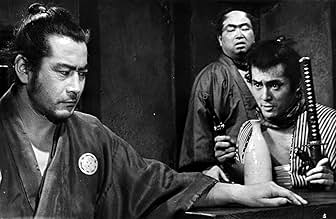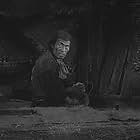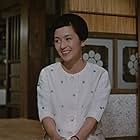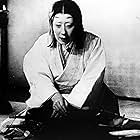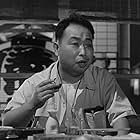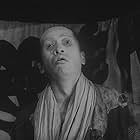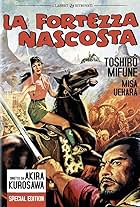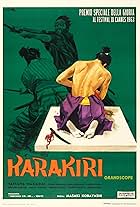VALUTAZIONE IMDb
8,2/10
134.388
LA TUA VALUTAZIONE
In un piccolo villaggio due fazioni si combattono da lungo tempo. Un giorno giunge nel villaggio un samurai che, saputa la situazione, decide di offrire i suoi servigi ad una delle due parti... Leggi tuttoIn un piccolo villaggio due fazioni si combattono da lungo tempo. Un giorno giunge nel villaggio un samurai che, saputa la situazione, decide di offrire i suoi servigi ad una delle due parti.In un piccolo villaggio due fazioni si combattono da lungo tempo. Un giorno giunge nel villaggio un samurai che, saputa la situazione, decide di offrire i suoi servigi ad una delle due parti.
- Candidato a 1 Oscar
- 5 vittorie e 2 candidature totali
Trama
Lo sapevi?
- QuizAkira Kurosawa told Toshirô Mifune that his character was like a wolf or a dog and told Tatsuya Nakadai that his character was like a snake. Inspired by this direction, Mifune came up with Sanjuro's trademark shoulder twitch, similar to the way a dog or wolf tries to get off fleas.
- BlooperIn the initial fight scene, The Samurai cuts the first two adversaries in the mid-section, then slices the last man's arm off. That last man is first seen from behind holding the sword in his right arm above his head, but the arm holding the sword shown moments later is a left arm.
- Versioni alternativeThe initial US release ran only 75 minutes, 35 minutes shorter than the original version at 110 minutes.
- ConnessioniFeatured in 62nd Annual Academy Awards (1990)
Recensione in evidenza
If you ever watched Pulp Fiction and thought: movie cool was born here, or maybe you saw any single Sergio Leone movie and thought: this guy invented movie-cool (if you haven't, i thoroughly recommend it - Kill Bill is nothing to his Good, the Bad and the Ugly or Once Upon a Time in the West), then experience Yojimbo, or The Bodyguard. Kurosawa's camera sits behind Toshiro Mifune's man-with-no-name, inviting us to look up at the back of his head as he walks the earth, inviting us to be in awe of this man. And as he walks, super-cool walking-the-earth music plays. Later on, when he's taunted and asked to prove himself, he slices a guy's arm off and plays the petty, money-grabbing rival factions in the town he wanders into off each other.
If you have it in your mind that a guy called Kurosawa couldn't make movies that would impress you, that the cultural gap would be too great - be assured that Kurosawa's movies are rife with Western values. Sure, they are rife with Japanese values (i am told), but Kurosawa had a great appreciation of Western culture. He based many of his movies on Western texts, like Shakespeare, Dostoyevsky, or American gangster fiction and film. Yojimbo is one of the latter - inspired by the Dashiell Hammet novel Red Harvest (Hammett's novel The Maltese Falcon was put onscreen moment for moment by John Huston in the movie of the same name which immortalised Humphrey Bogart).
Actually, the history of the story of the lone wolf, the wanderer with a weapon, who rides into town to play off two warring factions against each other - is quite a story itself. Dashiell Hammett, an American, wrote a novel with an American private eye as the stranger. In 1961, Akira Kurosawa transposed this story to medieval Japan, after the fall of a dynasty, where a Samurai finds himself with no place to go (at the beginning, we see him throw a branch up in the air and walk the direction it falls), and no master to serve. A bodyguard with no-one to protect. In 1964, Sergio Leone transposed the screenplay of Yojimbo (nearly word for word) to the spanish desert, and he brought along a young television actor named Clint Eastwood, and together they revolutionised the western with Fistfull of Dollars, and created an entire genre, the Spaghetti Western, which sported among its attributes a gritty, desolate landscape, and a cynical, postmodern lack-of-values ideology (traditional American westerns had quite plush landscapes and were always black and white (good and evil) in their value system. Despite the massive influence of Fistfull of Dollars, it pales in comparison to both its predecessor Yojimbo, and its sequals, For a Few Dollars More and The Good the Bad and the Ugly. But still, both Yojimbo and Fistful are iconic movies, and very cool movies.
With cool music, a cool anti-hero, a fun script, and a visually spectacular canvas of an image, painted by the eye of an artist (it is said that Kurosawa storyboarded his movies in full-scale paintings), Yojimbo is one of the coolest movies ever made.
If you have it in your mind that a guy called Kurosawa couldn't make movies that would impress you, that the cultural gap would be too great - be assured that Kurosawa's movies are rife with Western values. Sure, they are rife with Japanese values (i am told), but Kurosawa had a great appreciation of Western culture. He based many of his movies on Western texts, like Shakespeare, Dostoyevsky, or American gangster fiction and film. Yojimbo is one of the latter - inspired by the Dashiell Hammet novel Red Harvest (Hammett's novel The Maltese Falcon was put onscreen moment for moment by John Huston in the movie of the same name which immortalised Humphrey Bogart).
Actually, the history of the story of the lone wolf, the wanderer with a weapon, who rides into town to play off two warring factions against each other - is quite a story itself. Dashiell Hammett, an American, wrote a novel with an American private eye as the stranger. In 1961, Akira Kurosawa transposed this story to medieval Japan, after the fall of a dynasty, where a Samurai finds himself with no place to go (at the beginning, we see him throw a branch up in the air and walk the direction it falls), and no master to serve. A bodyguard with no-one to protect. In 1964, Sergio Leone transposed the screenplay of Yojimbo (nearly word for word) to the spanish desert, and he brought along a young television actor named Clint Eastwood, and together they revolutionised the western with Fistfull of Dollars, and created an entire genre, the Spaghetti Western, which sported among its attributes a gritty, desolate landscape, and a cynical, postmodern lack-of-values ideology (traditional American westerns had quite plush landscapes and were always black and white (good and evil) in their value system. Despite the massive influence of Fistfull of Dollars, it pales in comparison to both its predecessor Yojimbo, and its sequals, For a Few Dollars More and The Good the Bad and the Ugly. But still, both Yojimbo and Fistful are iconic movies, and very cool movies.
With cool music, a cool anti-hero, a fun script, and a visually spectacular canvas of an image, painted by the eye of an artist (it is said that Kurosawa storyboarded his movies in full-scale paintings), Yojimbo is one of the coolest movies ever made.
- Ben_Cheshire
- 5 feb 2004
- Permalink
I più visti
Accedi per valutare e creare un elenco di titoli salvati per ottenere consigli personalizzati
Dettagli
Botteghino
- Lordo Stati Uniti e Canada
- 46.808 USD
- Fine settimana di apertura Stati Uniti e Canada
- 15.942 USD
- 28 lug 2002
- Lordo in tutto il mondo
- 64.919 USD
- Tempo di esecuzione1 ora 50 minuti
- Colore
- Proporzioni
- 2.35 : 1
Contribuisci a questa pagina
Suggerisci una modifica o aggiungi i contenuti mancanti

Divario superiore
By what name was La sfida del samurai (1961) officially released in India in Hindi?
Rispondi


